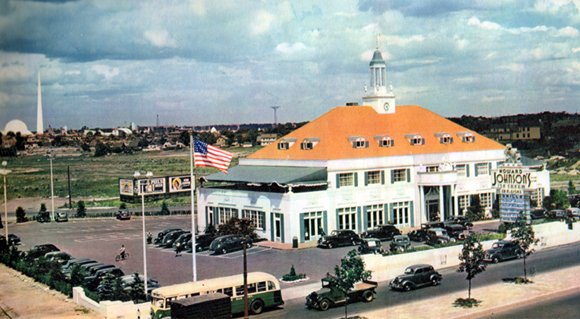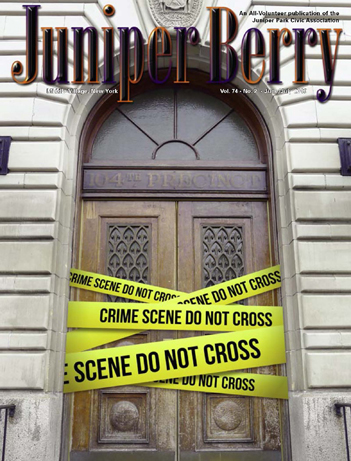Touted as the largest roadside restaurant in the world and built at a cost of $600,000 (the U.S. Bureau of Labor Statistics CPI calculator indicates that amount to be more than $9 million 2009 dollars!), the colossal Queens restaurant was designed by Howard Johnson’s chief architect Joseph G. Morgan and was erected by W. F. Babor & Co. Inc. An invitation only grand opening dinner was held on January 17, 1940 which ushered in Howard Johnson’s short lived foray into the realm of near-luxury dining.
The Queens store was the second Howard Johnson’s Restaurant financed by Lydia Pinkham Gove (her first was along the Jericho Turnpike on Long Island outside of Garden City and opened in August 1938). Queens was managed by Jonco Inc., the Howard D. Johnson Company’s New York subsidiary.
Apparently no expense was spared even in the midst of the Great Depression, and the Restaurant was awarded a bronze plaque for excellence in design and construction of buildings erected in Queens Borough during the year ending October 31, 1940 by the Queens Chamber of Commerce.
At least two New York Restaurants were financed by Lydia Pinkham Gove. Miss Gove was heiress to a fortune created by her grandmother’s Lydia Pinkham’s Herb Medicine.
Pinkham’s once well-known patent medicine was concocted by Lydia Pinkham in the 1870s. It was described as “a positive cure for all those complaints and weaknesses so common to our best female population.” Following Pinkham’s death in 1883, the company and its medicine survived the scrutiny of the Pure Food and Drug Act of 1906, subsequent regulation, and a long simmering family feud.
Miss Gove has been described as an enterprising woman! In addition to her role as treasurer of the Pinkham Medicine Company, and financier of HoJo’s, she was an aviator of sorts. In a history making five day flight in August of 1926, Lydia Pinkham Gove was the first person to fly in an airplane across North America as a paying passenger.
Moreover, in 1935 with money as no object during the Great Depression, she built a “home” modeled from Carcassonne Castle at a cost of $500,000 (nearly $8 million in 2009 dollars!!). She named the edifice, “Sky High.” With irony, Gove died on February 24, 1948 from complications of ovarian cancer. Her friend, Howard D. Johnson, donated $5,000 (about $45K in 2009 dollars) to the Runyon Fund in her memory.
As for Lydia Pinkham’s compound, it can still be purchased today—visit Numark Laboratories, Inc. for more information.
Winds of War
The United States had been mired in the Depression for some ten grueling years and worse, the winds of war were blowing from across the seas. The nation needed a distraction which fore-glimpsed better days ahead. New York’s 1939-’40 World’s Fair was the ticket! The Fair ran from April 30, 1939 to October 27, 1940, and was a showcase of progressive, prosperous modernity with corporations and nations producing exhibits of fancy. Visitors of the spectacle were witness to the “Dawn of a New Day”, and could see for themselves “the world of tomorrow.”
Realizing the potential for his Restaurant business, Howard D. Johnson welcomed and encouraged financiers like Miss Gove to assist him in expanding his empire in and around New York City in order to take advantage of the throngs of tourists “going to the fair, or anywhere!” Although the Queens HoJo’s did not have the entire run of the Fair since it opened in 1940, it nonetheless attracted many fair goers and reportedly enjoyed immediate successful operation.
As for the Fair, when it closed those among the European entourage were unable to return home due to the onset of WWII. Thus even after the War many remained in the United States and exercised considerable influence on American culture.
One example is Pierre Franey (above, left) who had been Poissonneur (a specialist in seafoods) at the French Pavillion working for Henry Soulé. After the Fair, Soulé opened his famed Le Pavillion (a restaurant both Johnson’s frequented) where Freney was recruited and remained from 1946 until 1960. When Soulé and Franey had a falling out in 1960, Chef Franey was hired by Howard D. Johnson. That a renowned chef would work for the Howard Johnson’s chain was considered scandalous at the time!
Chef Franey (who’s wife had been a Howard Johnson’s hostess during her pre-matrimony) was instrumental in creating and adapting many food specialties for use in the Howard Johnson Company’s then growing commissary system. Thus he significantly expanded Americans culinary experiences and expectations.
In a 1960 interview Mr. Franey said, “I look forward to the opportunity to present to the American public exclusive foods that are now only available in expensive restaurants in big cities.”
The Queens colossus was the culmination of Howard Johnson’s development from simple beachside stand into the ultimate in dining experience. Described as Colonial architecture, the monument to dining was decorated with Venetian blinds, crystal chandeliers made to order in Italy, elaborate murals, and exuded an overall expansive and impressive atmosphere of luxury.
Moreover, the palatial thousand seat restaurant’s main entryway was under a white-pillared portico which led into an elliptical hall of noble proportions. Within that entry hall was a wide grand stairway which wound gracefully upward toward a great rose and gold crystal chandelier, and along the walls were striking murals painted by the celebrated colorist, Andre Durenceau.
Like the progress promised by the much celebrated World’s Fair, the Queens HoJo’s pointed to a future that was not quite to be.
Business Week reported on June 19, 1943 that war-time gasoline rationing had taken its toll on Howard Johnson—Queens was among the three quarters of Howard Johnson’s Restaurants shuttered for the duration of the War. After the War, Johnson decreed that there would be no more roadside cathedrals. Following the 20th century’s greatest conflagration, Johnson completely refocused his orange roofed chain away from any pretense at luxury—its purpose would be to serve the burgeoning and increasingly mobile middle class of Americans providing them with an unprecedented standardized product and quality of service!
Freezer to Fortune;
The Amazing Story of Howard Johnson 1941
“The Largest Roadside Restaurant in the World.” Masterpiece of restaurants opened in 1940 on Queens Boulevard in the Forest Hills section of New York City, just outside the World’s Fair park. Three stories in height and built at a cost of $600,000, this building boasts its own bakery and two complete kitchens. Seating capacity in winter is about 700. In summer two awninged terraces on the second floor, furnished in cool wicker and pastel cushions, invite 300 more guests to linger over a frosty drink.
The three dining rooms are so restful and so attractive that at first we miss some of the details which go to make their perfection … the thick soft carpets … the glittering chandeliers … the blue green Venetian blinds, the maroon leather upholstery … the restrained use of color in walls and draperies … the charm of a light-fountain playing in the Empire Room.
Across the hall from the Empire Room upstairs is the Colonial Room. Both are available for private parties, weddings, Communion breakfasts, bridge parties, and other social gatherings. The kitchens are marvels of efficiency. Everything moves like clockwork. Four thousand dinners are served on Sunday with less fuss then you or I would entertain our in-laws. When you’re in New York, don’t fail to eat at “Queens” . Tell your friends about it. It isn’t just another restaurant. It’s a Waldorf Astoria of a place! It’s a dream come gloriously true!”
The “Queen” of the chain
Queens Boulevard, L. I., New York
Twenty years ago, many of the millions of people who came from the far corners of the nation to visit the 1940 WORLD's FAIR the guests of our young and stately “Queen” who had come to reign on the Boulevard in 1939. Billy Rose's original Aquacade, a neighbor to her majesty, was a popular and famous entertainment spot. The celebrities of this water spectacular were frequent guests of our reigning beauty. Indeed, she was a regal sight as one drove along a then sparsely settled Queens Boulevard.
Years of successful service took their toll — her regal robes had lost some of their dignity, the ermine that once trimmed her velvet cloak had shed its lustrous fur. TIME TO REFURBISH. TIME TO UPLIFT.
Mr. Joseph Cicco, Chief Architect, redesigned a complete new wardrobe for our “Queen” — the modern look. As the pictures indicate, elegant furnishings were selected, modern equipment installed — including the new Admanation dishwashing machine which in this unit handles an extremely high volume of business; competent personnel, as loyal subjects to our “Queen” are stationed in every department. With confidence, she reopened her doors and once again towers over all she surveys along the completely built up “Boulevard of Profits” . Her majesty the “Queen” reports –“sales ahead by 30% over last year's figures.”
Howard Johnson's Landmark: Sept-Oct, 1959
Remembering Howard Johnson’s on Facebook
I Remember Fairyland Amusement Park – Karen Smith Pavone
Marjorie Melikian: My friend and I were in there shortly before it closed, and lamenting its closure to the waitress. She said they’d be back – that they planned to open a new one in the building that replaced it. Obviously they never did. It would not have been the same anyhow, without its lovely big building. and with the dreadful changes to the chain the new management imposed.
Michael Glangevlin McGovern: Used to go there and get an ice cream soda in a tall glass with chocolate chip ice-cream. Still picture myself sitting at the counter. YUM!
Lillian Carubia: Koziol Does anyone remember the all-you-could-eat fish Friday? I have the best memories of the family there on a Friday gorging ourselves on fried ? I think it may have been flounder or sole. They used to have trays full of fried clams and flounder.
Teddy Rutledge: My mother LOVED their fried clams. Ummm…can taste the mac and cheese!!
Doug Carroll: First time I had Pistachio ice cream was at Howard Johnson’s. Also their fried clams were great and I don’t like clams on the half shell.
Phyllis Kornbluh Levitt: HoJos had turquoise carpet and a lovely dining room where the fried clams were the best! I can still taste the vanilla ice cream with the vanilla specks n it too.
Ann Mentasti: When I was in high school on the days we “weren’t” going to school we would meet here have breakfast and decide where we were going to hang out until it was time to be home from school.
Helen Hauswald: A day at Fairyland, then ice cream at this HoJo’s was such a treat when we were kids.
Deborah Harris: They use to put pickles on the table and we use to eat them while we waited for our egg creams or ice cream
Elliot Pollack: I remember the ice cream counter as you walk in.Also,the long staircase that led up to the ballroom where parties were held.




